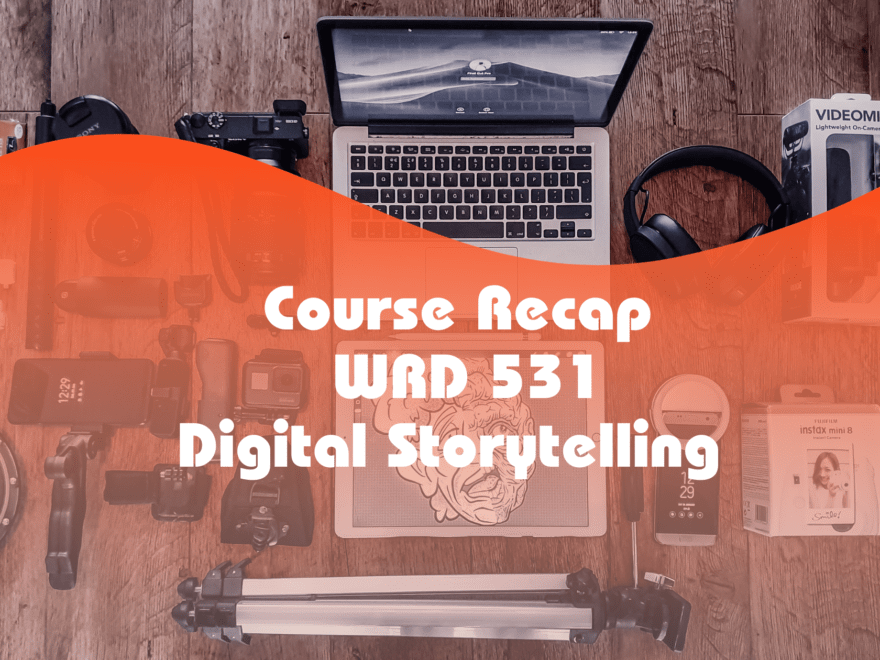This past Winter Quarter, Dr. Lisa Dush taught MAWRD’s sixth iteration of WRD 531: Digital Storytelling. This course gives students the opportunity to craft short digital personal experience narratives (DPENs) and to learn about how such narratives are circulated for organizational and community-building purposes. Exploring the processes, norms, and ethics of digital storytelling, this course enables students to better conceptualize and execute digital storytelling projects in both personal and professional contexts.
I had the opportunity to take WRD 531 this past quarter, and below I share some of the main class components and takeaways articulated by Dr. Dush, MAWRD student Maya Muschitz, and myself.
Course Overview
As an elective in MAWRD”s Professional and Digital Writing concentration and the SWAN certificate program, this course tends to bring together students from different fields. This time, students came from DePaul’s graduate programs in WRD, creative writing, writing and publishing, and arts leadership.
Personally, this variety of perspectives was one of my favorite aspects of the course. My learning was deepened through hearing the perspectives of this diverse group and how each of us related to digital storytelling in unique ways based on our experiences and fields of study.
The class was in Flex modality, meaning that half the students attended online in the Zoom-enabled classroom, while half of us attended in person. This also made for an interesting experience, as we collaborated in the classroom, online, and across programs.
We completed several projects starting with our own digital story (video) based on the California Digital Storytelling method (CDS), which we read about in our course textbook, Digital Storytelling: Capturing Lives, Creating Community. The second story we crafted was an interview-based written story, emulating those that one might find on a nonprofit website as a client or donor biography. . Additionally, we completed a landscape analysis paper and presentation, where each of us looked at a specific sector of nonprofit or other relevant digital storytelling to notice trends and compile best practices for practitioners. Finally, we explored diverse course materials including readings, videos, and podcasts to ground our learning in theory, storytelling methods, and examples.
Student Highlights
I chatted with first-year MAWRD student Maya Muschitz, who shared that she enjoyed the broad range of tasks in the course. She noted, “I was intimidated at first by having to come up with creative story concepts, but it ended up being a lot of fun. Having the freedom tp be creative not only in your story, but the way it was told felt very freeing, and then just seeing your story start to take on a life of its own and come together at the end was great.”
For myself, I found it fascinating to see the quality of narrative and emotion the 3-4 minute digital stories created by my classmates were able to achieve. Even while working with the same format, technology, and time constraints, each story was so distinct and powerful, ranging from personal topics on ailing family members to young love to the personal impact of gardening. The level of creativity required challenged me to step outside of my comfort zone and was a unique WRD class experience for me. Sharing the experience with my classmates and hearing their personal stories was my favorite part of the course.
Application Beyond the Classroom
Maya shares, “Before this course, I didn’t know much about digital personal narrative or digital storytelling; I’d done versions of them in previous classes and at my job but had never before put a label on it. Next time I’m tasked with writing a story at work, I know I’ll feel much more capable of coming up with a good product, and just being more comfortable with the task. Since taking this class, I’m now planning on getting the SWAN Certificate to keep growing these skills!”
I also plan on getting a SWAN certificate, so I felt the discussions of best practices and ethical considerations to be especially important for storytelling work I may do in nonprofit settings. Leaving the class with several different completed stories in different formats will also be helpful evidence of the skill set I developed in WRD 531.
Dr. Dush also notes the diverse applicability of course concepts, noting that “As a key aspect of professional writing intended to compel change, digital storytelling experience is useful for aspiring professional writers of all kinds.”
Final Takeaways
I was grateful to take a course that felt both highly relevant to my current and future professional roles and highly creative. Reading the case studies and theoretical readings in the class made for a great mix of discussion, and I am excited to tell more stories in media formats I may not have been confident exploring prior to this course.
Maya shared that she learned primarily “How empowering storytelling can be! We watched, read, and heard so many powerful stories throughout the quarter, both from outside organizations and our fellow classmates. Storytelling is such an important tool, not just for organizations to share their work and help others, but in helping everyday people tell their own stories on their own terms, sharing glimpses into their own lives and struggles.
“Getting people to open up and be vulnerable with their personal experiences is a big responsibility, and I’m glad that we all were able to come out of this class being better suited to take that on.”
Maya Muschitz
